Metals X and the case for a tin bull market
Tin is a metal critical to maintaining a modern lifestyle. Tin is used extensively in solder for critical electronic components such as circuit boards for the machines we use every day. It is estimated that tin comprises between 1-5% of a circuit boards total weight, with more complex boards requiring higher portions of solder. There is no substitute available for tin for soldering applications.
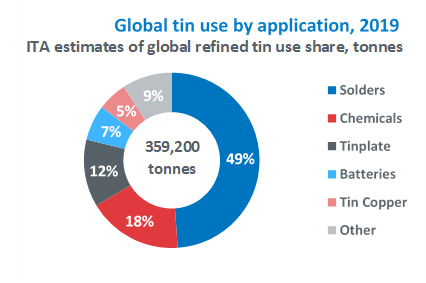
Source: International Tin Association (ITA)
Tin usage and demand is expected to grow in line with technological progression. Rio Tinto in 2018 identified tin as the metal most impacted by new technologies given the heavy reliance on advanced electronic controls and boards that the deployment of these new technologies require.
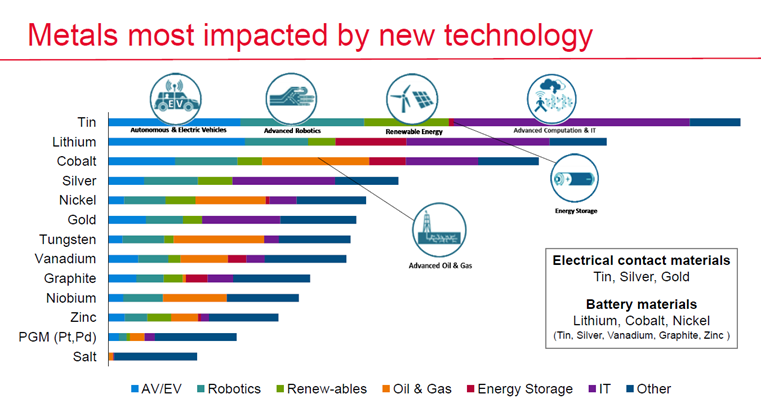
Source: Rio Tinto
China and Indonesia are the largest sources of tin production, followed by Myanmar, Russia, Bolivia, Peru and the Democratic Republic of the Congo.
Global tin production has been relatively stable over the past, with demand exceeding supply for a number of years. This gap has been filled historically via the secondary refining of tin and the sell-down of historical strategic stockpiles by sovereign players.
COVID has exposed the fragility of global supply chains and tin has not been immune to supply disruptions. For instance, we have seen power cuts in the Yunnan region and volcanoes erupting in the DRC over the past week; both globally significant production areas.
In markets that are subject to supply constraints, we often see enormous moves in prices when a supply shock occurs. An example being the uranium markets in 2006 when the globally significant Cigar Lake uranium mine flooded; this triggered an increase in the spot uranium price of 350% over a 12-month period before spot prices began to retrace.
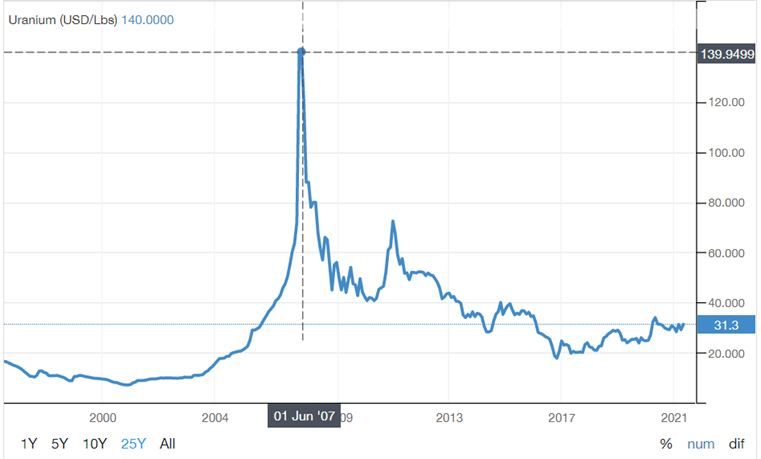
Source: Trading Economics
The futures markets are a great place to understand the dynamics of forward pricing for commodities. In usual circumstances, we can expect the term structure of a range of futures over a commodity to be in 'contango' which means that prices tend to be more expensive the longer the duration of futures contract. Intrinsically this makes sense, as for physical commodities there is a tangible cost in storing the materials.
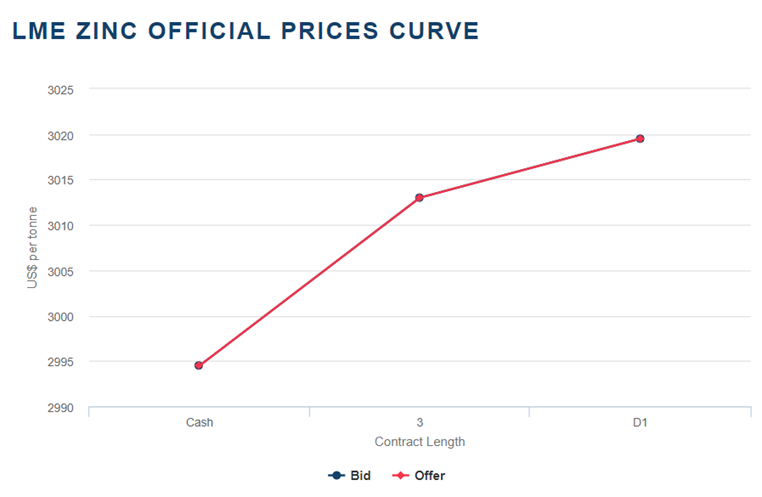
Source: London Metal Exchange (LME)
In this case, tin futures are in 'backwardation' where the spot contract is the highest priced with longer durations priced more cheaply. This is a relatively rare situation that demonstrates short-term market supply stress. However, on the London Metals Exchange, this situation has persisted for the last 3 months and has now occurred on the second major commodity market in the Shanghai Futures Exchange.
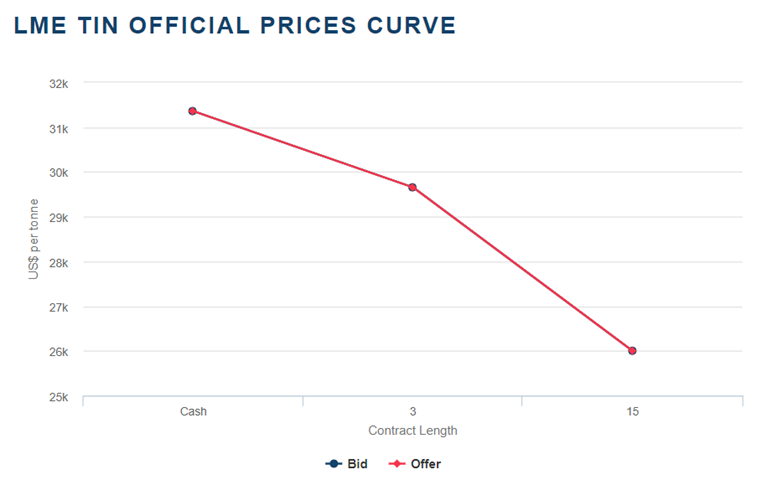
Source: London Metal Exchange (LME)
The situation has been supportable in the short term on the LME, as commodity traders could source metals or perform arbitrage on the SHFE and deliver to the LME. With tin on both exchanges in backwardation, the arbitrage opportunity is not so obvious anymore. Across these two major commodity exchanges, less than 6 days of global tin demand remains in stock. Accordingly, we believe that tin spot prices have the potential to trade at significantly higher prices over the next 1-6 months.
We believe the best place to capture potential returns from tin, is by investing in existing producers. On the ASX, we have one of the best-listed exposures globally in Metals X (ASX: MLX).
MLX's Renison project is located in Tasmania. 50% of Renison is owned by Yunnan Tin (the world's largest tin producer) who picked up a stake in the GFC-era when MLX was distressed. Renison currently produces around 7,000t of tin per annum.
We expect that the quality of resource will improve over time at Renison with 'Area 5' reserves (a new deposit yet to be exploited) providing a 58% uplift in grade relative to recent ore processed. This translates to tin production in excess of 11,000t per annum on a 100% basis assuming all other factors remain constant. In addition, metallurgical recovery improvements expected via investment in process improvements. In particular, a thermal upgrade or tin fumer scoping study due in Q3 is likely to improve recovery rates materially and lead to a significant improvement in financial outcomes.
MLX also hold a significant growth opportunity in Rentails, a tailings stockpile accumulated from previous processing. Rentails is the second largest undeveloped tin deposit globally when measured by tin content in the mineral reserve. At current tin prices of US$31,000 a tonne and assuming no uplift from the tin fumer process, we value Rentails at a pre-tax NPV8 of circa $300 million net to MLX.

Source: International Tin Association (ITA)
MLX has historically had a mixed record management-wise however, present management appear to be pragmatic and commercial in their decision making.
Non-core copper assets have been sold with non-direct exposure to potential upside via an equity and derivative holding in Cyprium Metals (ASX:CYM).
A spinoff of MLX's nickel assets is expected to be completed this year with an in-specie distribution of stock planned for MLX shareholders. We have seen positive financial outcomes for holders of ILU & ALK who have conducted similar transactions in the past 12 months, and we expect the same case here.
Shareholders will also benefit from the large embedded tax losses from legacy operations. This is a hidden asset that is value accretive but not valued by the market.
We believe that MLX holds good takeover potential with its non-core assets now largely divested. Yunnan Tin would be the most logical acquirer of MLX however, given current geopolitical circumstances a transaction may be difficult in the short term.
On a sum of parts valuation, we consider that MLX is worth at least $350 million or circa 40c per share - with further potential upside of $300 million should Rentails proceed successfully into production and the tin price remaining at present levels.
Access a unique portfolio of Australian growth opportunities
Datt Capital are specialists in identifying high growth and special situation opportunities. If you share our passion for uncovering undiscovered gems, Datt Capital could be the right investment for you. Click 'CONTACT' below to get in touch with us.
Enjoy this wire? Hit the ‘like’ button to let us know. Stay up to date with my content by hitting the ‘follow’ button below and you’ll be notified every time I post a wire.
Disclaimer: This article does not take into account your investment objectives, particular needs or financial situation; and should not be construed as advice in any way. The author holds shares in Metals X (MLX:ASX).
2 topics
2 stocks mentioned